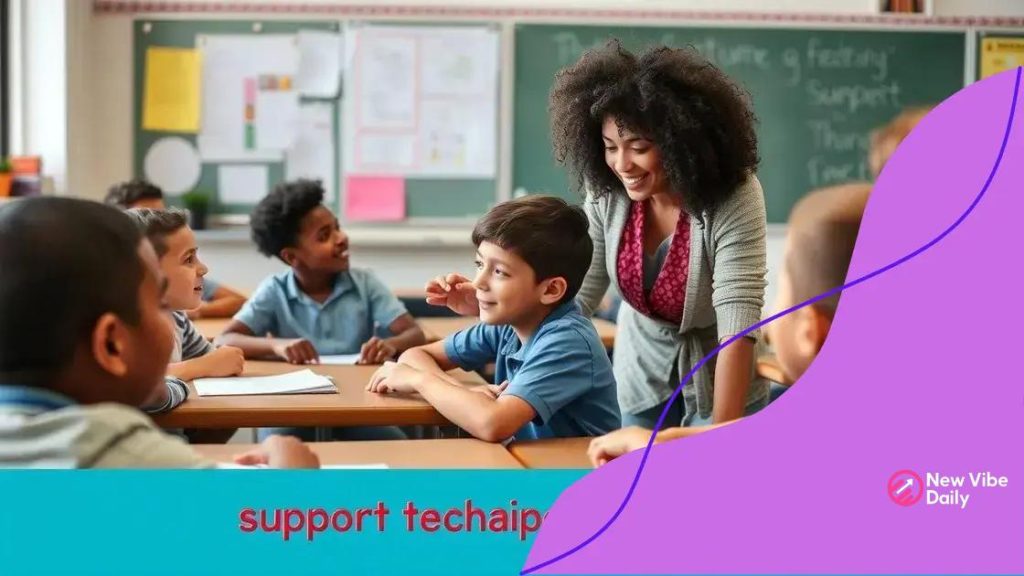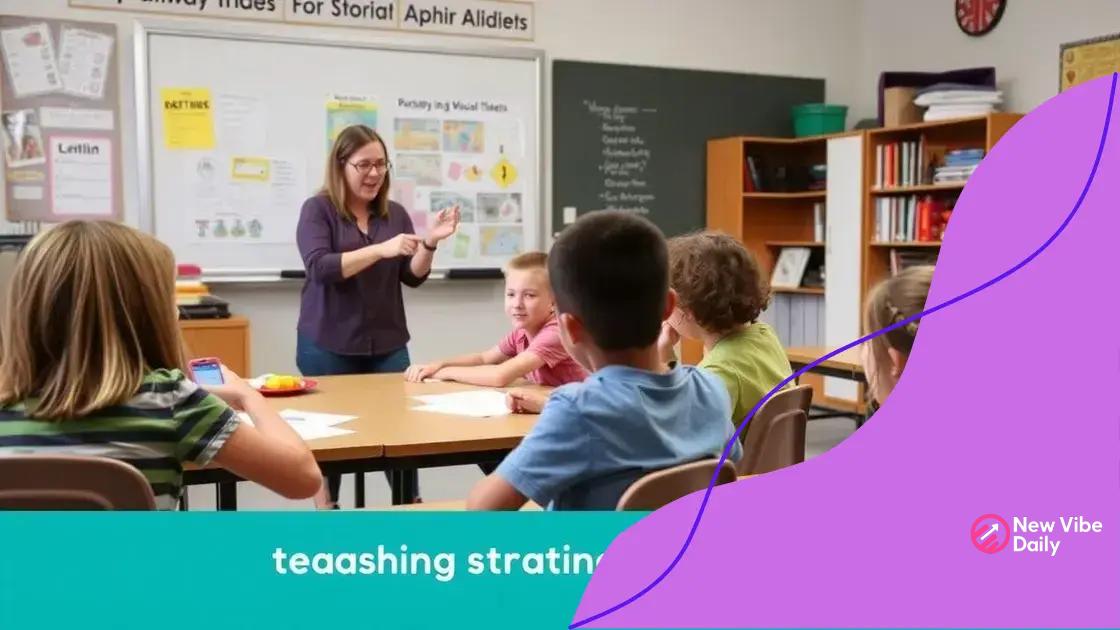Supporting students with ADHD: strategies that work

Supporting students with ADHD involves collaborating with parents, monitoring progress, and adopting flexible teaching strategies to create an inclusive learning environment that meets their unique needs.
Supporting students with ADHD is essential for fostering a conducive learning environment. Have you ever wondered what techniques can really help these unique learners thrive? This article dives into effective strategies that can enable success.
Understanding ADHD in students
Understanding ADHD in students is vital for creating a supportive classroom environment. ADHD, or Attention Deficit Hyperactivity Disorder, affects many students differently. By learning about the characteristics of ADHD, educators can better accommodate these learners.
Key Characteristics of ADHD
Students with ADHD often display a range of behaviors that can affect their learning experience. It’s important to identify these traits to help guide teaching strategies:
- Inattention to details
- Difficulty staying focused
- Impulsivity in decision-making
- High levels of energy and restlessness
Recognizing these signs helps in tailoring educational practices. For instance, some students may struggle to complete assignments due to their inability to focus. Others might find it hard to sit still for extended periods, impacting their participation in class activities. By understanding ADHD, teachers can implement strategies to enhance learning.
Effective classroom management plays a crucial role in supporting students with ADHD. Establishing a clear structure daily can significantly benefit these learners. For example, displaying a visual schedule allows students to anticipate what comes next, which can reduce anxiety.
Creating a Supportive Environment
Moreover, fostering a positive classroom environment encourages engagement. Teachers should promote open communication, allowing students to express their needs. Simple adjustments, like offering flexible seating options, can help students manage their restlessness.
Collaborating with Parents
Another important part of supporting students with ADHD is involving parents or guardians. Regular communication can help align strategies between home and school. When parents understand their child’s unique challenges, they can provide consistent support.
In summary, comprehending ADHD in students informs more effective teaching methods. It allows educators to meet learners where they are, enhancing their educational experience significantly.
Creating an inclusive classroom environment
Creating an inclusive classroom environment is essential for supporting all students, especially those with ADHD. A welcoming atmosphere encourages participation, reduces anxiety, and promotes effective learning. Everyone deserves to feel valued and included in their learning space.
Understanding Inclusion
An inclusive classroom embraces diversity, allowing students of all backgrounds and abilities to thrive. This approach not only benefits those with ADHD but also enhances learning for all students. Relationships among peers become stronger when everyone understands and supports each other.
- Recognizing different learning styles
- Encouraging collaboration and teamwork
- Fostering empathy and respect
- Providing necessary resources and assistance
Implementing these elements can make a substantial difference in how students interact and learn. The key lies in building connections and encouraging open communication. Teachers can create opportunities for students to work together, learning from one another’s strengths.
Flexible Classroom Setup
The physical layout of a classroom can significantly influence its inclusivity. Flexible seating arrangements can benefit students with ADHD who may struggle to stay focused. Offering choices like bean bags, standing desks, or floor cushions can help students find their comfort zone.
A classroom filled with visuals and interactive materials also captivates students’ attention. Wall charts, colorful displays, and designated areas for various activities can enhance engagement. When students feel stimulated and connected to their environment, they are more likely to participate.
Encouraging Positive Behavior
Recognizing and rewarding positive behavior is crucial in an inclusive setting. Teachers can create a system that acknowledges students’ efforts, fostering motivation. Simple praise or rewards for milestones can encourage students to engage with their peers, which is especially helpful for those with ADHD.
Ultimately, it’s about creating a space where all students feel comfortable and confident to express themselves. A well-structured, inclusive classroom benefits everyone, leading to improved academic and social outcomes.
Effective teaching strategies for ADHD

Effective teaching strategies for ADHD students are essential to help them succeed academically. Understanding how students with ADHD learn differently can guide educators in applying diverse methods that cater to their unique needs.
Using Visual Aids
Visual aids can make lessons more engaging and easier to understand. Many students with ADHD benefit from seeing information represented visually. Charts, diagrams, and videos can help reinforce key concepts.
- Use colorful charts to summarize important points.
- Incorporate videos that illustrate topics in an interactive way.
- Provide handouts that highlight essential information.
- Utilize graphic organizers to help students outline their thoughts.
These tools make learning more interactive, allowing students to connect better with the material and stay focused.
Incorporating Movement
Another effective strategy is incorporating movement into lessons. ADHD students often have lots of energy, and incorporating physical activity can help them concentrate. Activities like brief movement breaks can recharge students’ focus.
Teachers can integrate short exercises such as stretching or light calisthenics between lessons. This not only helps students release pent-up energy but also improves their attention span when returning to academic tasks.
Providing Structure and Routine
Students with ADHD thrive in structured environments. Establishing a clear daily routine lets students know what to expect. Posting a daily schedule in the classroom gives students a visual guide to follow.
Moreover, breaking tasks into smaller steps can make assignments less overwhelming. When students see manageable parts of a project, they can focus on each step without getting discouraged. This approach encourages gradual progress and builds confidence.
Encouraging Positive Reinforcement
Recognizing students’ efforts can significantly motivate them. Teachers should give frequent positive feedback to ADHD students. Simple affirmations for participation or completing tasks can boost their self-esteem.
Creating incentive programs, like a reward system, can also motivate learners. For instance, earning points or stickers for good behavior encourages students to stay engaged. Recognition of small achievements helps reinforce positive behavior.
Overall, applying these effective teaching strategies empowers ADHD students to progress academically while feeling valued and supported.
Involving parents and guardians
Involving parents and guardians is a key element in supporting students with ADHD. When families engage with schools, it creates a collaborative environment that benefits students significantly. Communication between teachers and parents fosters a consistent approach to learning and behavior management.
Establishing Open Communication
Effective communication is essential. Teachers should maintain regular contact with parents to discuss their child’s progress. This can be done through emails, phone calls, or scheduled meetings. Sharing updates about what is happening in the classroom allows parents to feel more connected to their child’s education. It also gives them the opportunity to share their insights from home, which can be valuable.
- Provide regular updates on academic performance and behavior.
- Encourage parents to share strategies that work at home.
- Use a communication notebook for daily check-ins.
- Organize workshops to educate parents about ADHD.
These practices help create a strong partnership between home and school, enabling teachers and parents to work together effectively.
Encouraging Active Participation
Getting parents involved in school activities can also enhance their connection to the educational environment. Participation in volunteer opportunities or school events shows support for their child’s learning. When parents attend meetings, workshops, or special events, it demonstrates their commitment.
Encouraging parent-teacher conferences provides a platform for collaboration. During these meetings, teachers can share student strengths and areas for growth. Moreover, listening to parents’ concerns can lead to adjustments in teaching strategies that better support the student.
Resources and Support
Schools can assist parents by offering resources about ADHD and strategies to support their child at home. Providing pamphlets or links to reputable websites may educate families about possible challenges and effective techniques for managing behaviors.
Additionally, connecting families to support groups can provide emotional backing. These groups allow parents to share experiences and learn from one another, creating a sense of community.
Ultimately, the more involved parents and guardians are, the better support students receive, leading to improved academic outcomes and overall well-being.
Monitoring progress and adapting approaches
Monitoring progress and adapting approaches is crucial for supporting students with ADHD. Continuous assessment helps educators understand how well students are learning and which strategies are effective. By paying attention to each student’s unique needs, teachers can make adjustments that promote better outcomes.
Regular Assessments
Conducting regular assessments is a key part of tracking student progress. These can include formal tests, quizzes, and informal observations. Teachers should focus on both academic growth and behavioral improvements. This way, they can identify patterns in learning and behavior.
- Utilize formative assessments to gauge understanding.
- Keep track of homework completion and class participation.
- Engage in one-on-one conversations to discuss challenges.
- Monitor emotional well-being through check-ins.
By regularly assessing students, teachers can gain valuable insights into each child’s progress and make informed decisions about necessary changes.
Flexible Teaching Strategies
Based on assessment results, flexibility in teaching strategies is essential. What works for one student may not work for another. For example, if a student struggles with traditional teaching methods, it might be helpful to incorporate hands-on activities or technology.
Using varied instructional methods keeps lessons engaging and caters to different learning styles. Teachers can adapt approaches by incorporating:
- Visual aids and multimedia resources.
- Group work and collaborative projects.
- Interactive games to build skills.
- Movement breaks to maintain focus.
These adaptations help students feel more comfortable and motivated to learn.
Setting Achievable Goals
Setting specific, measurable, achievable, relevant, and time-bound (SMART) goals can aid in monitoring progress effectively. Students with ADHD benefit from clear, structured goals that they can work toward. Regularly reviewing and adjusting these goals helps maintain motivation and adjusts expectations based on progress.
Encouragement and support are key during this process. Recognizing small achievements boosts confidence and encourages students to keep trying. By celebrating progress, teachers reinforce a positive attitude towards learning.
In summary, monitoring progress is vital to ensure students with ADHD are receiving the support they need. Adapting teaching strategies based on this monitoring ultimately leads to improved student engagement and success.
Involving parents and guardians, monitoring progress, and adapting strategies are essential for supporting students with ADHD. By working as a team, educators and families can create a positive learning environment. Regular communication and collaboration ensure that each child’s needs are met. Effective teaching strategies are vital to keeping students engaged and motivated. In the end, the goal is to help these students succeed both academically and socially, empowering them to reach their full potential.
\n\n
\n
FAQ – Supporting Students with ADHD
How can parents support their child with ADHD?
Parents can support their child by maintaining regular communication with teachers, attending meetings, and helping with homework.
What are effective teaching strategies for ADHD students?
Effective strategies include using visual aids, incorporating movement, and providing structured routines to enhance focus and learning.
Why is monitoring progress important for students with ADHD?
Monitoring progress helps identify what is working and allows teachers to adapt strategies to better meet each student’s needs.
How can teachers involve parents in their child’s education?
Teachers can involve parents by providing regular updates on performance, inviting them to participate in school activities, and offering resources about ADHD.






